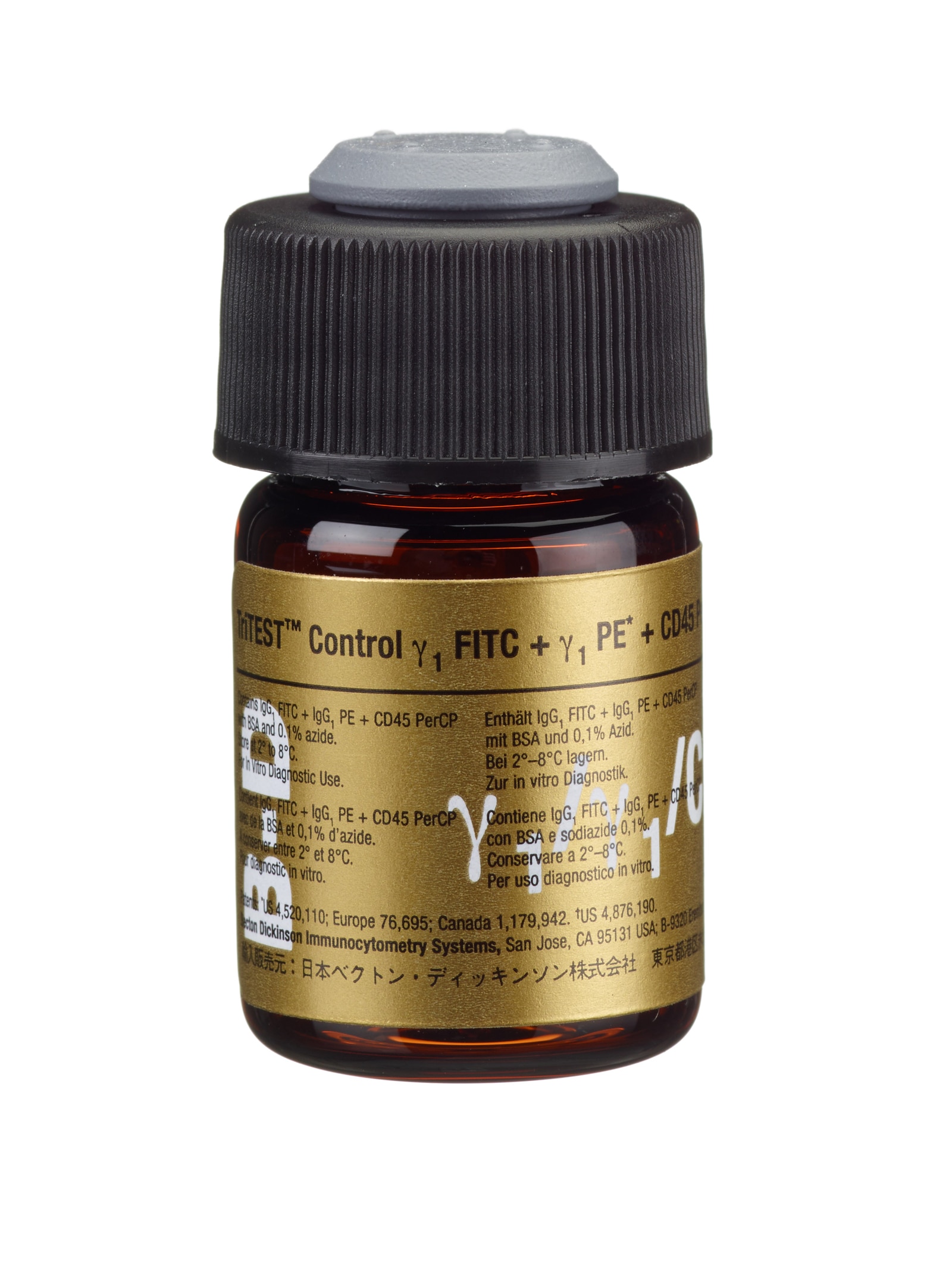Old Browser
Looks like you're visiting us from {countryName}.
Would you like to stay on the current country site or be switched to your country?
BD Tritest™ Control γ1 FITC/γ1 PE/CD45 PerCP
(IVD)

Control γ1 FITC/γ1 PE/CD45 PerCP
Regulatory Status Legend
Any use of products other than the permitted use without the express written authorization of Becton, Dickinson and Company is strictly prohibited.
Description
Becton Dickinson Immunocytometry Systems (BDIS) Tritest ™ Control, γ1 fluorescein isothiocyanate (FITC)/γ1 phycoerythrin (PE)/CD45 peridinin chlorophyll (PerCP), is a three-color direct immunofluorescence reagent used as an isotype (negative) control for flow cytometric immunophenotyping of erythrocyte-lysed whole blood with BD Tritest reagents on the Becton Dickinson family of flow cytometers. The Tritest Control is used to determine the unstained lymphocyte population on a fluorescence 1 (FL1) vs fluorescence 2 (FL2) display and to determine any nonantigen-specific antibody binding (nonspecific staining) present, particularly that caused by Fc receptors. BD Tritest Control is for in vitro diagnostic use with BD in vitro diagnostic Tritest reagents.
Preparation And Storage
1. For in vitro diagnostic use.
2. Store the reagent at 2° to 8°C to maintain stability. Do not use after expiration date shown on the label.
3. Do not freeze the reagent or expose it to direct light during storage or during incubation with cells. Keep the reagent vial dry.
4. Do not use the reagent if you observe any changes in appearance. Precipitation or discoloration indicates instability or deterioration.
5. The antibody reagent contains sodium azide as a preservative; however, care should be taken to avoid microbial contamination, which may cause erroneous results.
| Description | Clone | Isotype | EntrezGene ID |
|---|---|---|---|
| CD45 PerCP | 2D1 | IgG1, κ | N/A |
| Mouse IgG1 Isotype Control PE | L293 | IgG1, κ | N/A |
| Mouse IgG1 Isotype Control FITC | X40 | IgG1, κ | N/A |
Development References (11)
-
Centers for Disease Control. Revised guidelines for performing CD4+ T-cell determinations in persons infected with human immunodeficiency virus (HIV). MMWR. 1997; 46:1-29. (Biology).
-
Centers for Disease Control. Update: universal precautions for prevention of transmission of human immunodeficiency virus, hepatitis B virus, and other bloodborne pathogens in healthcare settings. MMWR. 1988; 37:377-388. (Biology).
-
Clinical and Laboratory Standards Institute. 2005. (Biology).
-
Clinical and Laboratory Standards Institute. 2007. (Biology).
-
Clinical and Laboratory Standards Institute. 2007. (Biology).
-
Cobbold SP, Hale G, Waldmann H. Non-lineage, LFA-1 family, and leucocyte common antigens: new and previously defined clusters. In: McMichael AJ. A.J. McMichael .. et al., ed. Leucocyte typing III : white cell differentiation antigens. Oxford New York: Oxford University Press; 1987:788-803.
-
Giorgi JV. Lymphocyte subset measurements: significance in clinical medicine. In: Rose NR, Friedman H, Fahey JL, ed. Manual of Clinical Laboratory Immunology. 3rd ed.. Washington, DC: American Society for Microbiology; 1986:236-246.
-
Jackson AL, Warner NL. Rose NR, Friedman H, Fahey JL, ed. Manual of Clincial Laboratory Immunology, Third Edition. Washington DC: American Society for Microbiology; 1986:226-235.
-
Nicholson J, Browning S, Orloff S, McDougal J. Inactivation of HIV-infected H9 cells in whole blood preparations by lysing/fixing reagents used in flow cytometry. J Immunol Methods. 1993; 160:215-218. (Biology).
-
Nicholson J, Jones B, Hubbard M. CD4 Tlymphocyte determinations on whole blood specimens using a single-tube three-color assay. Cytometry. 1993; 14:598-605. (Biology).
-
Schwinzer R. Cluster Report: CD45/CD45R. In: Knapp W. W. Knapp .. et al., ed. Leucocyte typing IV : white cell differentiation antigens. Oxford New York: Oxford University Press; 1989:628-634.
Please refer to Support Documents for Quality Certificates
Global - Refer to manufacturer's instructions for use and related User Manuals and Technical data sheets before using this products as described
Comparisons, where applicable, are made against older BD Technology, manual methods or are general performance claims. Comparisons are not made against non-BD technologies, unless otherwise noted.
For In Vitro Diagnostics Use.
Report a Site Issue
This form is intended to help us improve our website experience. For other support, please visit our Contact Us page.